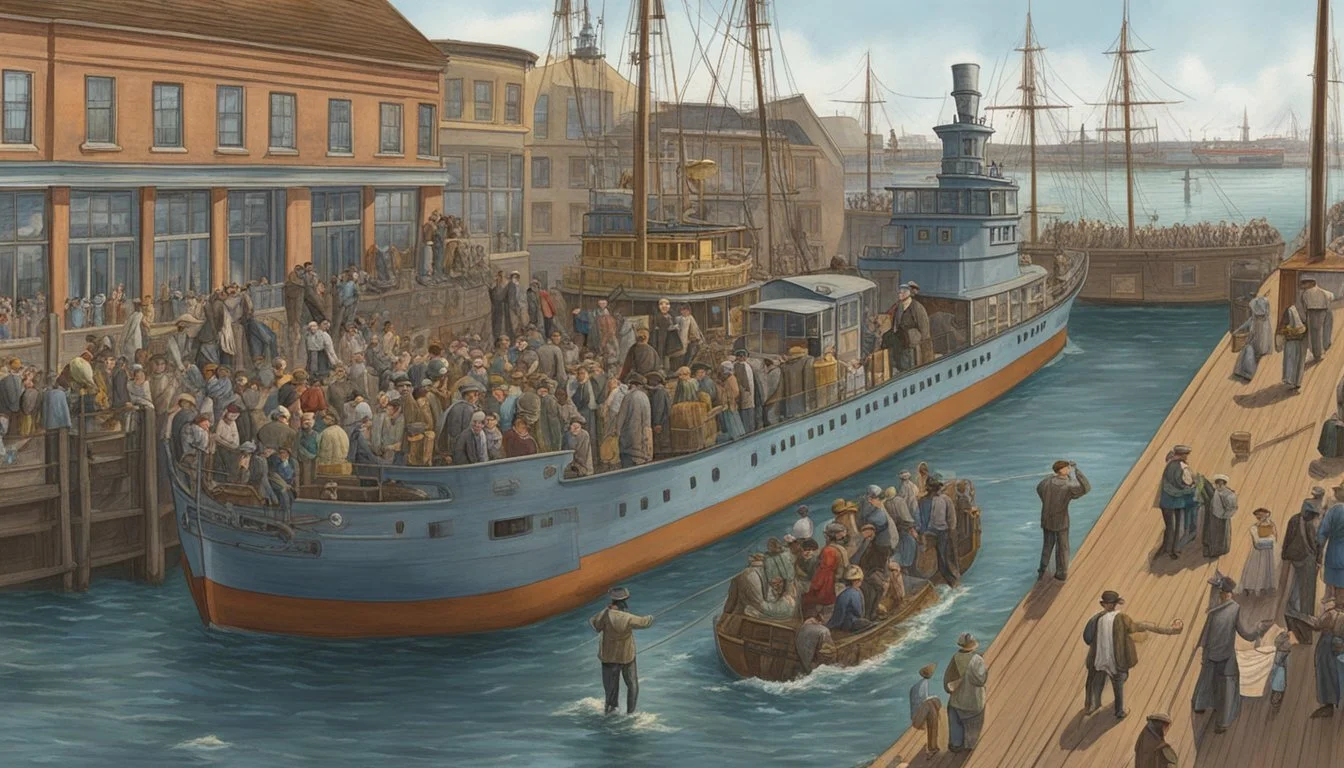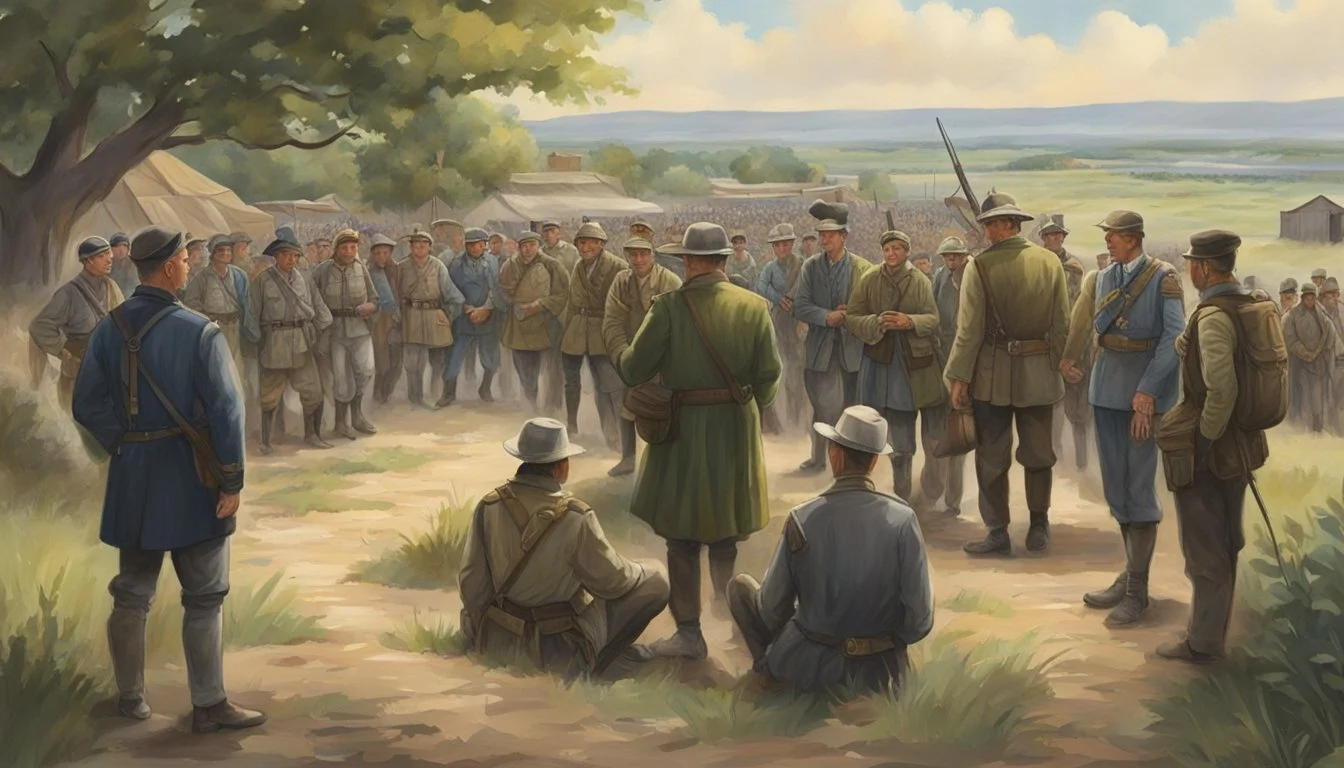The History of German Immigration to Texas
Cultural Legacy and Impact
German immigration to Texas played a pivotal role in shaping the cultural and social landscape of the state. In the mid-19th century, seeking opportunities and driven by economic and political motives, thousands of Germans embarked on the voyage to the New World. The influx of German settlers in Texas began in earnest during the period of the Republic of Texas, between 1836 and 1846. The Adelsverein, also known as the Society for the Protection of German Immigrants in Texas, was instrumental in organizing and promoting this migration, establishing new communities and supporting the settlers upon their arrival.
The first wave of German immigrants encountered a challenging and often unforgiving new environment. Despite hardships including disease and the difficulty of frontier life, many persevered to build thriving communities. Some settled in existing urban centers such as Galveston, Houston, and San Antonio, while others forged into the Texas Hill Country to establish agricultural settlements. Notable towns founded during this period include New Braunfels and Fredericksburg, which would become integral to the emerging "German Belt" of Central Texas – a region characterized by its significant German population and cultural influence.
By the turn of the 20th century, Germans accounted for a substantial portion of Texas's population, influencing its culture, economy, and social fabric. These communities maintained elements of their German heritage while also integrating into the broader Texan identity. This fusion of cultures has left an indelible mark on Texas, contributing to the diverse and multifaceted society that continues to evolve today.
Pre-Immigration Context
Before delving into the great tide of German immigration to Texas, it's important to understand the factors that led to this movement and why Texas became an attractive destination for German emigrants.
Europe's Push Factors
In the early 19th century, Germany was not yet a unified nation but a collection of separate states and principalities. The region faced significant social and economic pressures, including:
Overpopulation: Rural areas especially were densely populated, with limited resources to support the growing numbers.
Agricultural hardship: Frequent crop failures and consequential food shortages added to the strain.
Political unrest: The lack of a unified political structure led to fragmented and sometimes oppressive regional governance.
These conditions created a strong push factor for emigration, particularly around the year 1847, when these issues were increasingly acute.
Texas as a Destination
Texas presented itself as a promising land for those seeking to escape the hardships of their homeland. Factors contributing to its allure included:
Land opportunities: Expansive and fertile land was available, much of it suitable for farming and establishing new communities.
Economic potential: The burgeoning state, having recently gained independence from Mexico and later joining the United States, was in a period of economic growth.
Favorable reports: Testimonials and publications from earlier settlers painted Texas in a positive light, emphasizing the prospects for prosperity.
Early Settlements and Immigration Waves
German immigration to Texas began in the early 19th century and was characterized by the establishment of significant settlements, notably under the guidance of societies formed to aid immigrants. These settlements not only contributed to the state's cultural landscape but also paved the way for further German immigration.
Johann Friedrich Ernst and the First Settlers
Johann Friedrich Ernst, often considered the father of German immigration to Texas, received a land grant in 1831 and established the first permanent German settlement in present-day Austin County. His arrival, along with others, marked the beginning of a steady flow of German immigrants seeking opportunity on available land in Texas.
Adelsverein and the Establishment of New Braunfels
The Adelsverein, also known as the Society for the Protection of German Immigrants in Texas, was formed in 1842 to promote German settlement. This society played a pivotal role in establishing New Braunfels in 1845. The town quickly became a hub for German culture and an anchor for subsequent immigrants arriving from Germany.
Expansion into Fredericksburg and Central Texas
Leveraging the success in New Braunfels, the Adelsverein facilitated the foundation of Fredericksburg in 1846, furthering the German presence in Central Texas. This town and others formed the core of what would become known as the German Belt, with German immigrants significantly contributing to the development of the land and local economies in these regions.
Social and Cultural Developments
The significant influx of German immigrants to Texas during the 19th century led to the formation of a unique cultural landscape. These communities fostered social cohesion, while simultaneously influencing the broader cultural fabric of Texas.
Formation of German Belt
The German Belt, a term referring to a concentration of German settlements in Central Texas, was largely the product of planned colonization. Towns like New Braunfels and Fredericksburg were established and became hubs for subsequent waves of immigrants. Such settlements formed the backbone of the German Belt, serving as focal points of social and cultural gathering.
Ethnic Enclaves and Chain Migration
German settlers often established ethnic enclaves as they sought the familiarity of their native culture. Chain migration played a crucial role, wherein initial migrants would send back "America letters" to their homelands, describing the opportunities awaiting in Texas. This correspondence encouraged more Germans to immigrate, often settling near friends and relatives, which preserved and reinforced their common identities.
Examples of Ethnic Enclaves:
Fredericksburg: Maintained a strong German cultural identity.
New Braunfels: Became a center for German traditions in Texas.
German Influence on Texan Culture
German migrants have left a lasting imprint on Texan culture. Texas German, a unique dialect, developed as an amalgamation of various German dialects spoken by immigrants. The culinary scene saw the introduction of beer and sausage, eventually becoming staples within Texan cuisine. Festivals and social gatherings, showcasing German roots, are prevalent and continue to celebrate the state’s rich German ancestry. This cultural melding notably contributed to the diverse tapestry that is Texas today.
Cultural Contributions:
Language: Texas German, an amalgamation of dialects.
Food: Introduction of German beer and sausage to Texas.
Heritage: Festivals and social activities celebrating German ancestry.
Economic Contributions
German immigrants in Texas have significantly influenced the state's economy since their arrival, notably in agriculture and business.
Agricultural Impact and Farming Communities
German immigrants played a substantial role in developing Texas's agricultural landscape. They introduced various farming techniques and crops suited to the Texas climate, thereby enhancing the productivity and diversity of Texas farms. A notable contribution was the establishment of farming communities such as New Braunfels and Fredericksburg, which not only increased the local economy but also influenced the cultural tapestry of the state. They cultivated a range of crops and contributed to the establishment of Texas's viticulture.
Crops Introduced:
Wheat and corn
Orchards (peaches, plums, and pecans)
Farming Techniques:
Crop rotation
Modern animal husbandry
Farmers from these communities played a crucial role as they often shared their knowledge and practices with non-German neighbors, leading to widespread agricultural advancements across the state.
Business and Urban Contributions
German influence extended to urban development and business within Texas. German immigrants who settled in urban areas, such as Galveston and San Antonio, contributed to the commercial and industrial sectors. They established various enterprises, from small businesses to banks, integrating themselves into the economic fabric of Texan society. Their entrepreneurial spirit was instrumental in accelerating the development of urban infrastructure and commerce. In these settings, they were often seen:
Establishing breweries, reflecting their rich brewing heritage.
Founding financial institutions, which were pivotal in providing capital for further economic expansion.
Through these efforts, German immigrants not only found individual success but also bolstered the broader economy and laid groundwork for future prosperity. Their legacy can still be seen in the thriving industries and community establishments that originated from these early economic contributions.
Political and Military Involvement
German immigrants in Texas were not only significant in their cultural and economic contributions, but they also played notable roles in the political and military spheres of the state, particularly during the Civil War and in the subsequent political landscape.
German Texans During the Civil War
During the American Civil War, German Texans experienced a deep internal conflict. Many of them harbored anti-slavery sentiments and supported the Union cause, which put them at odds with the prevailing Confederate sentiment in Texas. Despite this, several German Texans ended up fighting for the Confederacy, whether by force or voluntarily, showing a complex alignment with both regional and ethnic loyalties.
Association with the Union: Known for their Unionist tendencies, a considerable number of German Texans opposed Texas joining the Confederacy.
Military Engagement: German Texans formed military units, with one of the most notable being the Texas Hill Country Unionists.
Casualties: The Battle of the Nueces, in particular, was a tragic event where pro-Union German Texans were killed while attempting to flee to Mexico to avoid Confederate conscription.
Post-War Politics and Social Standing
After the Civil War, German Texans found themselves in a transformed political landscape. Many of the survivors faced scrutiny and at times, hostility, for their Union support during the war.
Reconstruction: They navigated the tumultuous Reconstruction era, with some even holding political office in an effort to shape a post-war Texas that aligned more closely with their views on civil liberties and democracy.
Social Order: Over time, their influence helped to cement their role within Texas society, contributing to the broader political and social order of the state.
Inclusion in the Republic: Their involvement in Texas politics extended back to the days of the Republic of Texas, and this continued engagement helped integrate German perspectives into the fabric of Texas governance.
Challenges and Adversity
German immigrants in Texas faced significant obstacles, from anti-German sentiment during World War I to the struggle of preserving their unique cultural identity.
Anti-German Sentiment and World War I
During World War I, German-Americans, including those in Texas, were subjected to a swell of anti-German sentiment that spread across the United States. This animosity was fueled by the United States' engagement in the war against Germany and its allies. In Texas, individuals of German descent encountered ostracism and violence; some were even tarred and feathered. Their loyalty to the United States was often questioned, and they found it increasingly difficult to maintain their heritage openly.
German-Texan Heritage Society: Formed to counter these pressures and preserve German cultural legacy, the German-Texan Heritage Society became a platform for German Texans to celebrate and promote their history, language, and traditions in a way that also exemplified their American identity.
Preservation of Heritage and Identity
Preserving cultural identity amidst a dominant personality of American culture posed as another profound challenge for German immigrants. The pressure to assimilate and the surrounding discrimination threatened their traditional customs and languages.
Language Schools: In response, communities often established German-language schools and churches to maintain their linguistic identity. However, these institutions struggled as English increasingly became the preferred language for business and education, leading to a gradual decline in the daily use of German over generations.
Modern Day Legacy
The German influence in Texas extends well beyond the historical context of immigration, persisting strongly in the cultural identity and community events of the state today.
German Ancestry in Texas
Texans with German ancestry represent a significant portion of the state's demographic makeup. They maintain a connection to their heritage through various means, including participation in local societies dedicated to preserving German-Texan history. Notably, the German-Texan Heritage Society serves as a hub for those interested in exploring their roots and preserving the language, traditions, and history of their ancestors.
Organizations such as these often provide genealogical resources, educational programs, and community outreach efforts to celebrate and continue the German legacy within Texas.
Cultural Festivals and Societies
German-Texan heritage is celebrated throughout the year with numerous cultural festivals. Evidently, these festivals serve as a testimony to the German influence embedded in Texas' cultural tapestry. A few standout examples include:
Oktoberfest in Fredericksburg: A traditional festival celebrating German food, beer, music, and dance, drawing thousands of visitors annually.
Wurstfest in New Braunfels: A ten-day festival known as a "salute to sausage," offering a variety of German meats, bread, and other cultural delicacies alongside entertainment.
Moreover, societies like the German-Texan Heritage Society not only organize events but also work diligently to keep traditions alive through language courses and community engagement, reinforcing the bonds between Texas' present and its German-influenced past.
Research and Documentation
The study of German immigration to Texas is supported by extensive research materials and documentation found in historical societies, archives, and digital resources. These collections offer a structured approach to understanding the influence of German culture on Texan society.
Historical Societies and Archives
The Portal to Texas History and the German-Texan Heritage Society are two pivotal entities supporting the study of German-Texan heritage. The Portal to Texas History includes a rich compilation of artifacts such as maps, photographs, manuscripts, and books that chart the German influence on Texas. This digital repository acts as a valuable resource for researchers and historians. On the other hand, the German-Texan Heritage Society maintains an archive of historical documents and offers genealogical services, fostering the preservation and study of the German impact in Texas.
Books and Digital Resources
Among available literature, one notable book is "The Germans in Texas; A Study in Immigration" by Gilbert Giddings Benjamin. Originally published in 1901, this book provides a well-documented analysis of German immigration from 1815 to 1848. It is a critical resource for historical research available through various academic libraries.
In conjunction with books, digital resources enhance the accessibility of information on this topic. For instance, The Portal to Texas History not only offers physical documents but also provides digitized copies, greatly expanding the reach of its collection for users worldwide.
Researchers and enthusiasts may explore various media formats for comprehensive insights into the German-Texan narrative, thereby allowing a multi-faceted approach to understanding this chapter in immigration history.





